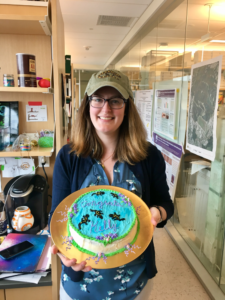
Pictured: Kelly Barnhart celebrating with a salamander cake and hat.
Kelly Barnhart successfully defends her Master’s thesis- “From Symbionts to Pathogens: Interactions Within the Amphibian Skin Mucosome”.

Pictured: Kelly Barnhart celebrating with a salamander cake and hat.
Kelly Barnhart successfully defends her Master’s thesis- “From Symbionts to Pathogens: Interactions Within the Amphibian Skin Mucosome”.
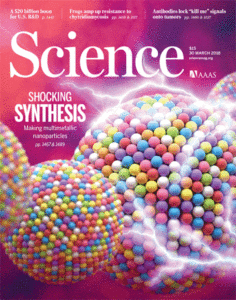
Science Magazine publishes a sweeping study including 15 years of Dr. Woodhams’ research. In collaboration with Jamie Voyles at University of Nevada, Reno, the study describes rebounding populations of amphibians in Panama. Rather than a weakening pathogen, the research shows that host skin defenses or biotic community factors may be responsible for creating conditions for coexistence of amphibians and the chytrid fungus.
Voyles J, Woodhams DC, Saenz V, Byrne AQ, Perez R, Rios-Sotelo G, Ryan MJ, Bletz MC, Sobell FA, McLetchie S, Reinert L, Rosenblum EB, Rollins-Smith LA, Ibáñez R, Ray JM, Griffith EJ, Ross H, Richards-Zawacki CL. (2018) Shifts in disease dynamics in a tropical amphibian assemblage are not due to pathogen attenuation. Science 359(6383):1517-1519.
Link to article | Link to New York Times article | Link to Science News | Link to The Atlantic article
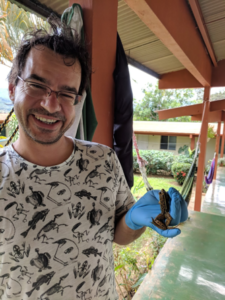
Pictured: Dr. Andreas Hertz with Panama leopard frog
Dr. Hertz and Woodhams captured Panama leopard frogs, Rana pipiens species E, near Santa Fe, Panama. The undescribed species is similar to Northern leopard frogs but may produce unique skin peptide secretions with medicinal properties.
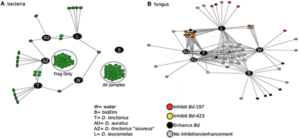
Network analysis depicting the connectivity among sample for Bd inhibitory bacterial (A) and Bd-inhibitory/facilitating fungal (B) taxa.
In this new article published in Frontiers in Microbiology, the Woodhams Lab in collaboration with the New England Aquarium suggests that host associated fungi may work better than bacteria for amphibian skin probiotics against chytridiomycosis.
Patrick J. Kearns, Sarah Fischer, Saioa Fernández-Beaskoetxea, Caitlin R. Gabor, Jaime Bosch, Jennifer L. Bowen, Michael F. Tlusty, and Douglas C. Woodhams. Fight Fungi with Fungi: Antifungal Properties of the Amphibian Mycobiome. (2017) Frontiers in Microbiology.
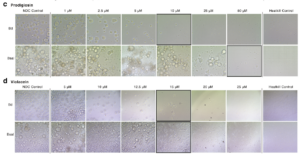
Prodigiosin and Violacein are two bacterially produced chemicals that inhibit fungal amphibian pathogens
In a new study, Woodhams and colleagues show that compounds such as prodigiosin and violacein produced by amphibian skin bacteria can inhibit fungal pathogens. Volatile organic compounds were also inhibitory. The team showed that these bacteria are widespread and potentially useful probiotics.
Woodhams DC, LaBumbard BC, Barnhart KL, Becker MH, Bletz MC, Escobar LA, Flechas SV, Forman ME, Iannetta AA, Joyce MD, Rabemananjara F, Gratwicke B, Vences M, Minbiole KPC. (2017) Prodigiosin, violacein, and volatile organic compounds produced by widespread cutaneous bacteria of amphibians can inhibit two Batrachochytrium fungal pathogens. Microbial Ecology, https://doi.org/10.1007/s00248-017-1095-7
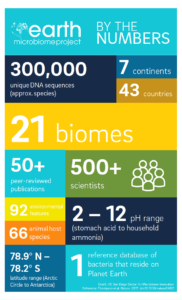 Dr. Woodhams contributes to the Earth Microbiome Consortium of over 500 scientists, and a new paper in Nature led by Luke Thompson, “A communal catalogue reveals Earth’s multiscale microbial diversity.” This will become a key database, and a framework to place future microbiome studies in a global context.
Dr. Woodhams contributes to the Earth Microbiome Consortium of over 500 scientists, and a new paper in Nature led by Luke Thompson, “A communal catalogue reveals Earth’s multiscale microbial diversity.” This will become a key database, and a framework to place future microbiome studies in a global context.
Popular press stories can be found here: http://www.earthmicrobiome.org/news/, or download the paper: https://www.nature.com/articles/nature24621
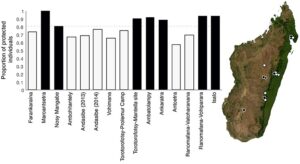
Herd immunity may protect some amphibians from disease on Madagascar.
A study led by Molly Bletz estimates herd immunity against amphibian chytridiomycosis in Madagascar.
Bletz MC, Myers J, Woodhams DC, Rabemananjara FCE, Rakotonirina A, Weldon C, Edmonds D, Vences M, Harris RN. (2017) Estimating herd immunity to amphibian chytridiomycosis in Madagascar based on the defensive function of amphibian skin bacteria. Frontiers in Microbiology.
https://www.frontiersin.org/articles/10.3389/fmicb.2017.01751/full
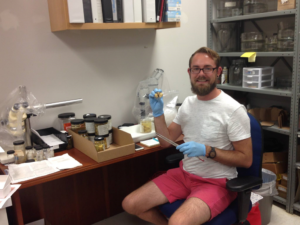
Ph.D. student Brandon LaBumbard sampling crayfish at the North Carolina Museum of Natural Sciences
“The Non-molluscan Invertebrate Unit welcomes UMass Boston Ph.D. student Brandon LaBumbard into the lab this week. Brandon’s research focuses on effects of chytrid fungus in amphibian declines. So, why is he holding a crayfish in this photo? Crayfishes are potential vectors by which chytrid is spread. Brandon is working with the NMI Collection’s extensive virile crayfish (Faxonius virilis) holdings, sampling for chytrid presence on, and in, these organisms. The virile crayfish is of particular interest as it has been widely introduced into regions of North America where chytrid has been particularly problematic.” By Bronwyn Williams on the Invertebrates, North Carolina Museum of Natural Sciences Facebook page from September 6, 2017 https://www.facebook.com/groups/1413271208984999/?fref=nf
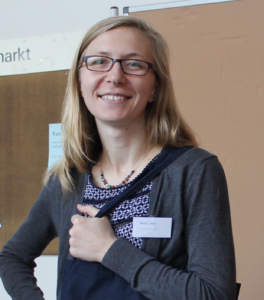
Smith Conservation Fellow, Dr. Molly Bletz
Molly Bletz (Ph.D., Technical University of Braunschwig, Germany) was awarded a prestigious Smith Conservation Fellowship to join the Woodhams lab and work on the project: Proactive conservation: curbing the threat of an emerging salamander pathogen by assessing disease risk and developing effective mitigation strategies.
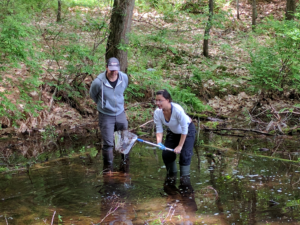
Alma Basco (REU student from University of Puerto Rico) catches her first newt.
National Science Foundation supported Research Experience for Undergraduates student Alma Basco (University of Puerto Rico), presented her summer research on “Developing a probiotic for proactive conservation of Eastern newts,” Alma Basco, Brandon LaBumbard, Douglas C. Woodhams.